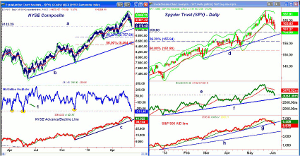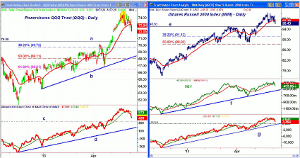After notching one all-time high after another with nary a pause, the market has registered a series of increasingly sharper pullbacks in recent weeks, and MoneyShow’s Tom Aspray takes a technical look to see if a rebound is imminent.
The stock market was punished again Wednesday with just 800 stocks advancing and 3276 declining. Each of the ten major sectors closed the day lower as the weaker than expected ADP Employment Report and continued nervousness over the Fed’s future plans were a good excuse to sell.
Overnight, stocks in Asia were punished again with Singapore stocks down over 1.5%. Stocks in Europe are trying to stabilize and the US stock index futures are higher in early trading. The ECB kept rates unchanged today, and of course, Friday we get the monthly jobs report.
Many investors are wondering whether they should be buying now or if stocks will drop even further before the worst of the selling is over. A close look at the market internals will help investors and traders navigate what could be a difficult month in the markets.
Chart Analysis: The daily chart of the NYSE Composite goes all the way back to the June 2012 lows as it closed Wednesday below initial support at 9265. There is further support just a bit lower at 9143 (line a).
- The daily starc- band is being tested with the short-term uptrend at 9041.
- The 38.2% Fibonacci retracement support from the June 2012 lows is at 8757, which is just above the March low at 8700.
- The uptrend from the lows, line b, is now in the 8500 area.
- The McClellan oscillator (a short-term A/D indicator) closed at -311 Wednesday.
- This is short-term oversold reading that was last seen in May and June of 2012.
- At the November 14, 2012, lows it hit -258.
- As was the case in June 2012, the oscillator will often form a bullish divergence at the market’s actual lows (point 1).
- The NYSE Advance/Decline dropped below its WMA on May 23 as I had noted previously. It has now broken its uptrend, line c, that goes back to the November 2012 lows.
- There is initial resistance in the 9350-9450 area, which includes the declining 20-day EMA and the monthly pivot line.
The Spyder Trust (SPY) closed Wednesday 4.6% below its all-time high at $169.07.
- There is next good support at $159.80 and the daily starc- band.
- The minor 38.2% support calculated from the November lows is at $155.94, which is 7.8% below the highs.
- There is a band of further support down to the 50% level at $151.89.
- The daily on-balance volume (OBV) did confirm the recent highs before dropping below its WMA.
- The OBV has broken its uptrend at line e, with more important support at the uptrend, line f.
- The S&P 500 A/D line has dropped further below its now declining WMA and has broken its short-term uptrend, line g.
- There is more important support for the A/D line at line h.
- There is initial resistance at $163.87 and the flat 20-day EMA with much stronger in the $166 area.
NEXT PAGE: 2 ETFs Race to the Bottom
|pagebreak|The chart of the Powershares QQQ Trust (QQQ) shows that it is still well above the September highs at $70.58, line a. The monthly pivot support is at $70.68.
- The QQQ has held up much better than the SPY as it is down just 3.8% from its high at $74.95.
- The 38.2% Fibonacci retracement support from the November 2012 lows is at $69.72.
- The 50% support is at $68.11 with the uptrend, line b, a bit higher at $68.23.
- The Nasdaq 100 A/D line formed lower highs before dropping below its WMA.
- The A/D line has next support at the April highs, line c, and much more important at the uptrend, line d.
- The 20-day EMA is at $72.94 with further resistance in the $73.40-80 area.
The iShares Russell 2000 Index (IWM) is also holding above the April highs at $95.10 (line e) and is now down just 3.9% from the high at $100.98.
- The monthly pivot stands at $92.91 with the 38.2% support from the November lows at $91.12.
- There is important chart support in the $89 area with the 50% support at $88.26.
- The daily OBV has dropped slightly below its WMA but acts much stronger than the OBV on the SPY.
- The Russell 2000 A/D has dropped below its WMA and is still well above converging support at line g.
- There is first resistance now at $98.25 to $99.15.
What it Means: The market is likely close to a short-term low. In the next week, we should see a pretty decent rebound that could take the S&P 500 back to the 1635-1645 area and possibly even 1660. Bearish sentiment is increasing as the number for bullish individual investors from the AAII has dropped to 29.7% down from 48.9% on May 23.
For the NYSE Composite and Spyder Trust (SPY), the expected rebound should be followed by a further decline that could take them to new correction lows.
The better relative performance of the Powershares QQQ Trust (QQQ) and the iShares Russell 2000 Index (IWM) indicates they could bottom first and may be the market leaders once the market’s major uptrend resumes.
On a time basis, it has only been nine days since the market made its highs, and in my experience, the correction in the stock market should last longer. The oversold reading of the McClellan oscillator is unlikely to mark a final low but it could form a bullish divergence in a few weeks.
In conclusion, while there may be a few stocks that are making their lows now I don’t think that generally this is a dip to buy.
How to Profit: If the rebound is strong enough, it may allow for the purchase of an inverse ETF like the ProShares UltraShort S&P500 (SDS) at a reasonable risk/reward level to hedge your equity holdings.













